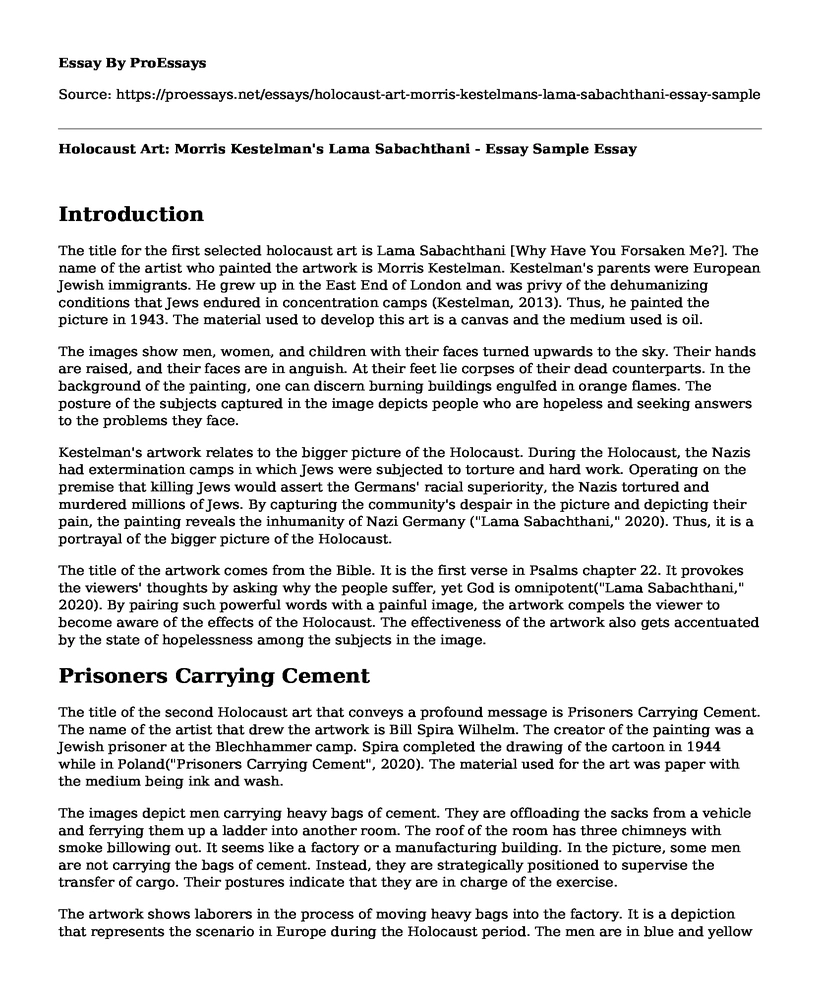Introduction
The title for the first selected holocaust art is Lama Sabachthani [Why Have You Forsaken Me?]. The name of the artist who painted the artwork is Morris Kestelman. Kestelman's parents were European Jewish immigrants. He grew up in the East End of London and was privy of the dehumanizing conditions that Jews endured in concentration camps (Kestelman, 2013). Thus, he painted the picture in 1943. The material used to develop this art is a canvas and the medium used is oil.
The images show men, women, and children with their faces turned upwards to the sky. Their hands are raised, and their faces are in anguish. At their feet lie corpses of their dead counterparts. In the background of the painting, one can discern burning buildings engulfed in orange flames. The posture of the subjects captured in the image depicts people who are hopeless and seeking answers to the problems they face.
Kestelman's artwork relates to the bigger picture of the Holocaust. During the Holocaust, the Nazis had extermination camps in which Jews were subjected to torture and hard work. Operating on the premise that killing Jews would assert the Germans' racial superiority, the Nazis tortured and murdered millions of Jews. By capturing the community's despair in the picture and depicting their pain, the painting reveals the inhumanity of Nazi Germany ("Lama Sabachthani," 2020). Thus, it is a portrayal of the bigger picture of the Holocaust.
The title of the artwork comes from the Bible. It is the first verse in Psalms chapter 22. It provokes the viewers' thoughts by asking why the people suffer, yet God is omnipotent("Lama Sabachthani," 2020). By pairing such powerful words with a painful image, the artwork compels the viewer to become aware of the effects of the Holocaust. The effectiveness of the artwork also gets accentuated by the state of hopelessness among the subjects in the image.
Prisoners Carrying Cement
The title of the second Holocaust art that conveys a profound message is Prisoners Carrying Cement. The name of the artist that drew the artwork is Bill Spira Wilhelm. The creator of the painting was a Jewish prisoner at the Blechhammer camp. Spira completed the drawing of the cartoon in 1944 while in Poland("Prisoners Carrying Cement", 2020). The material used for the art was paper with the medium being ink and wash.
The images depict men carrying heavy bags of cement. They are offloading the sacks from a vehicle and ferrying them up a ladder into another room. The roof of the room has three chimneys with smoke billowing out. It seems like a factory or a manufacturing building. In the picture, some men are not carrying the bags of cement. Instead, they are strategically positioned to supervise the transfer of cargo. Their postures indicate that they are in charge of the exercise.
The artwork shows laborers in the process of moving heavy bags into the factory. It is a depiction that represents the scenario in Europe during the Holocaust period. The men are in blue and yellow uniforms, which hints that they could be prisoners of war. Some of the Nazi camps were venues for selecting young and strong men to work as slaves in industries across the region("Prisoners Carrying Cement", 2020). These laborers lived in inhumane conditions and suffered while performing hard labor. Thus, the images capture the hardship and inhumane treatment that prisoners endured in the Holocaust.
The artwork is effective in relating the Holocaust to viewers through its depiction of the difference between the prisoners and their captors. The guard in the image stands close to a brazier with some smoke rising("Prisoners Carrying Cement", 2020). It implies that it is cold, but the prisoners have to carry heavy bags despite the harsh conditions. Hence, it is a presentation that makes the viewers aware of the lack of humanity in the Nazi camps and the burdens that slave laborers faced.
References
Lama Sabachthani [Why have you forsaken me?]. (2020). Retrieved from https://www.iwm.org.uk/collections/item/object/15255
Kestelman, M. (2013). Lama Sabachthani. Retrieved from https://krischristensen.wordpress.com/2013/05/12/lama-sabachthani-by-morris-kestelman/
Prisoners Carrying Cement. (2020). Retrieved from https://www.iwm.org.uk/collections/item/object/2307
Cite this page
Holocaust Art: Morris Kestelman's Lama Sabachthani - Essay Sample. (2023, Mar 28). Retrieved from https://proessays.net/essays/holocaust-art-morris-kestelmans-lama-sabachthani-essay-sample
If you are the original author of this essay and no longer wish to have it published on the ProEssays website, please click below to request its removal:
- Films Analysis Essay on Fight Club and The Godfather
- Essay on Lincoln and Colonization
- Compare and Contrast Essay on Malcolm X and Martin Luther King Jr.
- Analysis of the Film "The Battle of Algiers" Paper Example
- Architectural Design Digital Change Paper Example
- Essay Example on Forrest Gump: Mental Illness Portrayed Goofily
- 5-4-3-2-1 Structure: A Tonal Flux Journey - Research Paper







